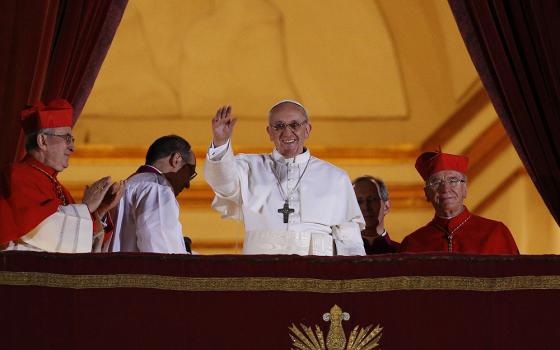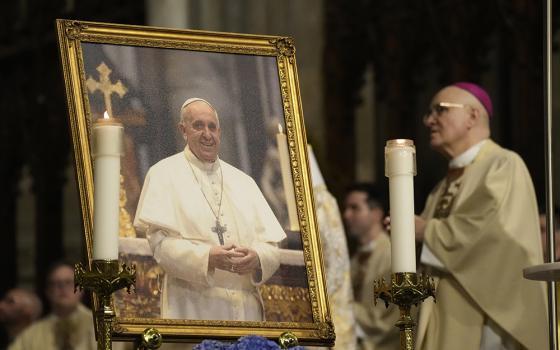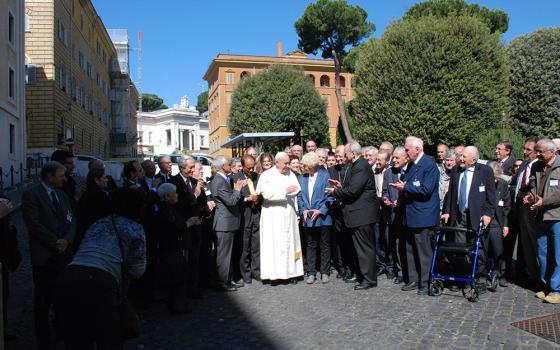A crucifix hangs before a mural depicting the Resurrection in the sanctuary at St. Timothy Parish in Mesa, Arizona. (Catholic Sun/OSV/J.D. Long-Garcia)
Waking up this Easter Monday, I’m tired. Holy Week in a parish can be exhausting — a balancing act of liturgical celebrations and one’s own prayerful reflection on the story of faith we tell and take part in. With the marathon of the Triduum behind us, today is a day for getting our bearings and taking stock. Easter Monday offers us a moment to begin again, to rest for a moment and feel the tension and the triumph of what has been and is yet to be.
Easter Monday is a tension point. Two parts of the memorial acclamation fall into place: Christ has died and Christ is risen. So what then remains? Christ will come again.
Just as we wake up holding the fruits and foibles of our Holy Week, the first followers of Jesus must have faced the same. For them, waking up the day after that first Easter must have felt like whiplash. Imagine everything the day before had held: the shock, the awe, the confusion, the unbelievable joy. Perhaps Jesus’ first followers never even went to sleep that first night and stumbled, in a state of emotional bewilderment, into what we now know as Easter Monday.
For them, of course, it was simply a Monday like no other they had ever experienced. I imagine that Peter and John could feel the tension in their leg muscles, having run to the tomb; that the two who had trekked back on the road from Emmaus kept playing that fateful journey over and over in their heads, remembering what it felt like to be broken open like the bread before them. I imagine Mary Magdalene awoke with puffy and swollen eyes, the scent of oil and spices still on her hands as she rubbed her face and tried to comprehend that the One she had so deeply mourned was once again alive.
There is an unbelievability to this day. The day after the day that everything changed, which of course, is and was three days after the day they thought was the day that changed everything. Yet, that is the thing we often forget about the Easter story: no one who took part in it knew what was going to happen.
In fact, I’d wager that it’s also the thing we forget about our own experiences of Easter — not just that we don’t know exactly how it’s going to turn out (which is true), but that (more often than not) we can forget that we are a part of this ongoing story.
Jesus is coming
"Where can I find someone to talk about hope?" a friend asked me a few weeks ago. That seems to be the perpetual question in this Jubilee Year of Hope. My friend, it seemed, was coming up short and losing hope in the process. "We’re not even halfway through this year, and I feel like my well is running dry." She opined.
Even just a day into this Easter season, I can feel her pain. Passion, death and resurrection feel like an all-too-common reality these days, with resurrection hope pulling up the rear (and, at times, limping to keep up!) With stories of deportations and job cuts, natural disasters and military attacks, the suffering of the cross, it would seem, is more of a daily occurrence than the empty tomb of Easter morning.
Still, as the day of the Resurrection opens into the Easter season, the tension of our faith invites us to hold the balance between blind hope and graced encounter. On Easter Monday, our faith invites us to hold the tension of the already and the not yet of Christ’s coming within the context of our current reality.
Advertisement
Christ has died. Christ is Risen. Christ will come again.
In the tension of current events and the temptation to despair, we hold firm to hope that Jesus is coming. This anticipation provides the hopeful tension of our lives, a tension holding us in suspense, buoying our spirits and pressing us to get over ourselves and on with life.
It’s in the hope of this coming that vowed religious life, with its evangelical counsels of chastity, poverty and obedience, is rooted. We make these vows to testify to the absoluteness of God. These vows also harken to the Second Coming. After all, who needs a next generation or a lofty savings or a 20-year plan when Jesus’ return is imminent?
Are such thoughts naïve? Or maybe idealistic? Is this the stuff of dreams, or is it the call of the Gospel?
For centuries, believers have lived in that tension. God makes all things new, including us. The fact that we can’t control or even predict Christ’s coming asks us to surrender. If Christ could come whenever and wherever, we best show up accordingly.
We are meant to be harbingers of hope. Jesus is coming. We need to live like we believe this fact.
Nearly fifty years ago, theologian Johann Baptist Metz underscored this point. "To live Christian hope on the basis of imminent expectation of the second coming does not mean sacrificing its social and political responsibility but the reverse," he wrote. Believing Christ will come again means injecting urgency into our actions. It means living up to the ideals we profess — living out of love and seeking justice here and now.
We can’t assume or presume that time will go on forever or that Christ’s coming again is theoretical. Such a presumption robs the promises of our faith of their "tension by extending the expectation of the second coming to infinity."
If we don’t believe the Reign of God can be a reality… we’ve already lost hope. In the words of St. Paul, "if Christ has not been raised, your faith is vain." (1 Corinthians 15:17a) Therefore, it is in the tension of faith lived in real life that we hold in tandem with what has already been and what is yet to be.
In that sweet spot of Easter Monday, we wait and we hope and we continue to act. To do any less is to dilute ourselves and our faith and to blatantly deny the promises of Christ to come again.
In that tension, we remain, and we remember. We remember the life of Jesus and give life to the Gospel in our day and age. And we do it all in hope — hope in the One who is to come and who calls us into being. The One who held tension all his life and continues to hold us in the tension of our day.
Just as the first followers couldn’t have known where they were in the story of Easter, we certainly can’t know where exactly we are, either. In that tension, we are stretched to find hope. Under pressure, we’re transformed in our belief. In distress, we're called to lean more closely into the One who knows the pain of injustice and the self-emptying way of love. And together, we ultimately follow the Way into our Easter reality and beyond.








